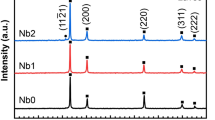Abstract
The corrosion of cobalt metal in gas mixtures containing argon, chlorine, and 0.5 atmosphere of oxygen has been studied by measuring the kinetics of the reaction using thermogravimetric techniques and by examination of the corrosion products using scanning electron microscopy. The corrosion products include both oxides and chlorides. The formation of volatile cobalt chloride plays a critical role in the corrosion process by attacking and penetrating the condensed oxide scale. At 1200 K, the Tedmon equation describes the kinetics of the corrosion process. At lower temperatures the corrosion behavior is more complex, and under some conditions the formation of a porous, nonprotective oxide scale can lead to rapid consumption of the metal.
Similar content being viewed by others
References
A. S. Kim, M.J. McNallan, and W. W. Liang:High Temperature Materials Chemistry-H, Z. A. Munir and D. Cubicciotti, eds., The Electrochemical Society, Inc.,Pennington,NJ, 1983, pp. 278–87.
K. Rheinhold and K. Hauffe:J. Electrochem. Soc, 1977, vol. 124, pp. 875–83.
Y. Ihara, H. Ohgame, K. Sakiyama, and K. Hashimoto:Trans. Jpn. Inst. Met., 1982, vol. 23, pp. 682–92.
Y. Ihara,H. Ohgame, K. Sakiyama, and K. Hashimoto:Corros. Sci., 1983, vol. 23, pp. 167–81.
W. W. Liang and K. H. Yun:Proceedings, Symposium on Corrosion-Erosion Behavior of Materials, K. Natesan, ed., TMS-AIME,Warrendale,PA, 1978, pp. 60–72.
JANAF Thermochemical Tables, 1974 supplement,J. Phys. Chem. Ref. Data, 1974, vol. 3, pp. 412–14, and 1975 supplement,J. Phys. Chem. Ref. Data, 1975, vol. 4, pp. 69-71, 79-80.
M.J. McNallan and W. W. Liang:J. Amer. Ceram. Soc, 1981, vol. 64, pp. 302–07.
R.E. Carter and F. D. Richardson:J. Metals, 1955, vol. 7, pp. 336–44.
H. S. Hsu and G.J. Yurek:Oxid. Metals, 1982, vol. 17, pp. 55–76.
C.S. Tedmon:J. Electrochem. Soc, 1966, vol. 113, pp. 766–68.
C.S. Giggins and F. S. Pettit:Metall. Trans., 1971, vol. 2, pp. 1071–78.
T. K. Liu and R. Bautista:Metall. Trans. B, 1983, vol. 14B, pp. 657–65.
P. Kofstad:High Temperature Corrosion, R. A. Rapp, ed., National Association of Corrosion Engineers, Houston,TX, 1983, pp. 123–38.
G. H. Geiger and D. R. Poirier:Transport Phenomena in Metallurgy, Addison-Wesley,Reading,MA, 1973, p. 352.
J. O. Hirschfelder, C. F. Curtiss, and R. B. Bird:Molecular Theory of Gases and Liquids, John Wiley and Sons, New York,NY, 1954, pp. 529–39.
Y. S. Kim and H. W. Pickering:Metall. Trans. B, 1982, vol. 13B, pp. 349–55.
J. B. Johnson, J. R. Nickolls, R. C. Hurst, and P. Hancock:Corros. Sci., 1978, vol. 18, pp. 543–53.
A. H. P. Skelland:Diffusional Mass Transfer, John Wiley and Sons, New York, NY, 1974, p. 117.
Author information
Authors and Affiliations
Additional information
Formerly Graduate Research Assistant
Rights and permissions
About this article
Cite this article
Maloney, M.J., McNallan, M.J. The effect of chlorine on the kinetics of oxidation of cobalt in environments containing 0.5 atmosphere of oxygen between 900 K and 1200 K. Metall Trans B 16, 751–761 (1985). https://doi.org/10.1007/BF02667511
Received:
Issue Date:
DOI: https://doi.org/10.1007/BF02667511




